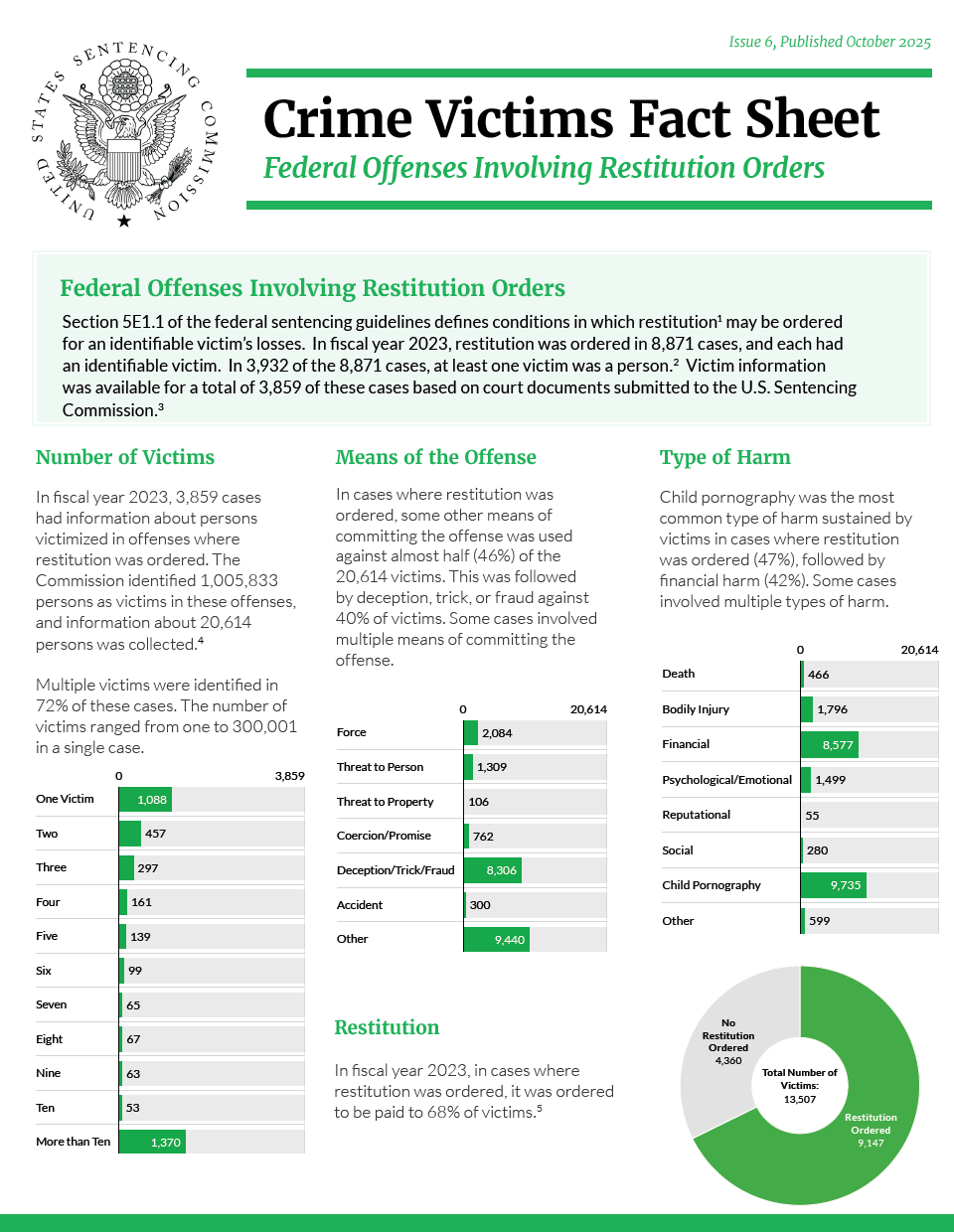CRIME VICTIMS FACT SHEET
Federal Offenses Involving Restitution
Section 5E1.1 of the federal sentencing guidelines defines conditions in which restitution1 may be ordered for an identifiable victim’s losses.
In fiscal year 2023, restitution was ordered in 8,871 cases, and each had an identifiable victim. In 3,932 of the 8,871 cases, at least one victim was a person.2 Victim information was available for a total of 3,859 of these cases based on court documents submitted to the U.S. Sentencing Commission.3
Click the button for a PDF or learn more below.
NUMBER OF VICTIMS
In fiscal year 2023, 3,859 cases had information about persons victimized in offenses where restitution was ordered. The Commission identified 1,005,833 persons as victims in these offenses, and information about 20,614 persons was collected.4
Multiple victims were identified in 72% of these cases. The number of victims ranged from one to 300,001 in a single case.
MEANS OF THE OFFENSE
In cases where restitution was ordered, some other means of committing the offense was used against almost half (46%) of the 20,614 victims. This was followed by deception, trick, or fraud against 40% of victims. Some cases involved multiple means of committing the offense.
TYPE OF HARM
Child pornography was the most common type of harm sustained by victims in cases where restitution was ordered (47%), followed by financial harm (42%). Some cases involved multiple types of harm.
RESTITUTION
In fiscal year 2023, in cases where restitution was ordered, it was ordered to be paid to 68% of victims.5
RELATIONSHIPS BETWEEN VICTIMS AND INDIVIDUALS WHO CAUSED HARM
In cases where restitution was ordered, the most common association between victims and the individuals who caused them harm was as a stranger (72%). The next most common association was as a customer or client (12%). Some cases involved multiple relationship types.
73% of victims in cases where restitution was ordered were harmed by more than one individual.
VULNERABILITY
Some cases where restitution was ordered involved victims who were unusually vulnerable due to age, physical or mental condition, or other factors.6 The Commission identified 50% of victims in these cases as unusually vulnerable for one of these reasons. Some cases involved multiple vulnerabilities.
VICTIM CHARACTERISTICS
More than half (57%) of victims in cases where restitution was ordered were juveniles.
Almost two-thirds (61%) of victims in cases where restitution was ordered were female.
ENDNOTES
1 Federal Offenses Involving Restitution Orders include cases from any federal sentencing guideline where restitution was ordered on behalf of an identifiable victim. See §5E1.1 (Restitution). The most common sentencing guideline for an offense where restitution was ordered was USSG §2B1.1 (Larceny, Embezzlement, and Other Forms of Theft; Offenses Involving Stolen Property; Property Damage or Destruction; Fraud and Deceit; Forgery; Offenses Involving Altered or Counterfeit Instruments Other than Counterfeit Bearer Obligations of the United States) at 46%.
2 An identifiable victim can be a person, business, government, or other type. This series provides victim information on persons.
3 The Commission’s Crime Victims Fact Sheets series relies on information collected and analyzed through a special coding project undertaken by the Commission to gather information beyond what is regularly collected and reported on by the Commission.
4 The sentencing documents received from the courts by the Commission are often focused on the sentencing event; therefore, some information regarding the victims of the offense was not provided in the documents available for staff review. For this reason, the total number of cases with complete information, and the corresponding number of victims in those cases, will vary by analysis. Victim information was collected for the first ten persons documented in the records.
5 Restitution may not have been ordered on behalf of each victim in a case.
6 In some, but not all, of these cases the court applied the adjustment at USSG §3A1.1. Vulnerability due to advanced age or youthfulness was determined by the offense conduct stated in the presentence investigation report adopted by the court, and not based on any minimum or maximum age.
SOURCE: U.S. Sentencing Commission, 2023 Victim Datafile, VICFY23.

